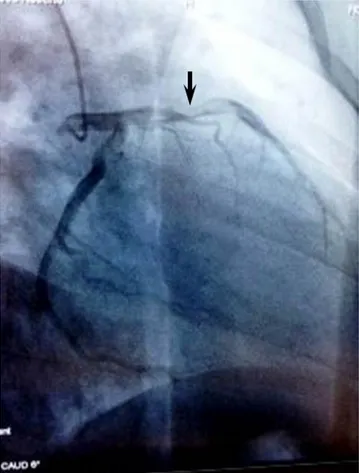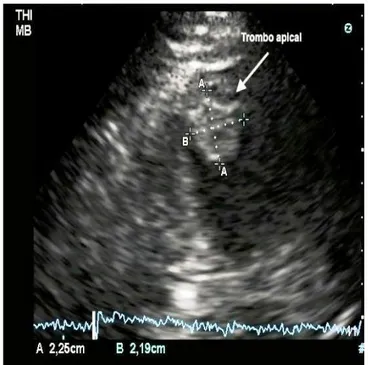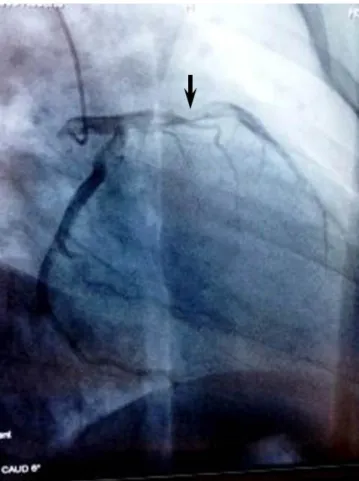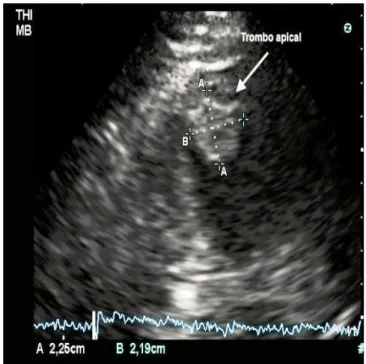Sociedad Cubana de Cardiología
______________________Casos Clínicos
Infarto agudo de miocardio como primera manifestación de
síndrome antifosfolípido
Dra. Esmeralda García Padilla
a, Dr. Eder N. Flores López
b, Dr. David L. Aguilar de la
Torre
c, Dr. Luis C. Álvarez Torrecilla
cy Dr. Rogelio López Alférez
da Facultad de Estudios Superiores Iztacala UNAM. Tlalnepantla, Estado de México.
b Servicio de Medicina Interna. Hospital General de Cuautitlán ISEM “General Vicente Villada”. Cuautitlán, Estado
de México.
c Servicio de Cardiología Intervencionista. Adscrito al Hospital General de Cuautitlán “General Vicente Villada”.
Cuautitlán, Estado de México.
d Clínica Florida Satélite. Naucalpan, Estado de México.
Full English text of this article is also available
INFORMACIÓN DEL ARTÍCULO
Recibido: 2 de febrero de 2014 Aceptado: 10 de abril de 2014
Conflictos de intereses
Los autores declaran que no existen conflictos de intereses
Abreviaturas
IAM: infarto agudo de miocardio SAF: síndrome antifosfolípido
Versiones On-Line: Español - Inglés
EN Flores López
Hospital “General Vicente Villada” Alfonso Reyes S/N, Santa María, Cuautitlán, CP 54820
Estado de México. Correo electrónico:
dr.eder.natanael@msn.com
RESUMEN
El síndrome antifosfolípido es una enfermedad autoinmune caracterizada por la com-binación de trombosis venosa y arterial, cuya forma de presentación es muy diversa. El infarto agudo de miocardio es una de sus presentaciones más inusuales. En este artículo se presenta un caso con este diagnóstico y trombo intracavitario, como forma de presentación del síndrome antifosfolípido.
Palabrasclave:Síndrome antifosfolípido, Infarto agudo de miocardio, Trombo
Acute myocardial infarction as the first manifestation of
antiphospholipid syndrome
ABSTRACT
Antiphospholipid syndrome is an autoimmune disease characterized by the combi-nation of venous and arterial thrombosis, whose presentation is very diverse. Acute myocardial infarction is one of the more unusual presentations. This article presents a case with this diagnosis and intracavitary thrombus as presentation form of antiphos-pholipid syndrome.
Palabrasclave:Antiphospholipid syndrome, Acute myocardial infarction, Thrombus
INTRODUCCIÓN
Infarto agudo de miocardio como primera manifestación de síndrome antifosfolípido
CorSalud 2014 Jul-Sep;6(3):271-274 272
Figura 1. Cateterismo cardíaco que muestra la coronaria
izquierda (oblicua anterior derecha con angulación caudal), con imagen de trombo en segmentos proximal y medio de la arteria descendente anterior (flecha), y flujo
TIMI III. El infarto agudo de miocardio (IAM), como forma
de presentación de dicho síndrome, es muy raro. Para poder determinar su existencia se cuenta con criterios clínicos y serológicos. Dentro de estos últimos se re-quiere la presencia de anticoagulante lúpico, anticar-diolipinas IgG o IgM (títulos mayores a 40 GPL o MPL) o anti ß2-glicoproteína-I (ß2-GPI) IgG o IgM positivos (títulos mayores a percentil 99) en al menos 2 oportu-nidades, separadas por 12 semanas, según los criterios de Sapporo modificados2.
Los criterios diagnósticos de IAM, según la tercera definición universal de infarto3 son:
1. Detección de un aumento o descenso de los valores de biomarcadores cardíacos (preferiblemente tro-poninas), con al menos un valor por encima del percentil 99 del límite de referencia superior y con al menos uno de los siguientes:
- Síntomas de isquemia.
- Nuevos o supuestamente nuevos cambios signi-ficativos del segmento ST-T o nuevo bloqueo de rama izquierda del Haz de His.
- Aparición de ondas Q patológicas en el electro-cardiograma.
- Pruebas por imagen de nueva pérdida de mio-cardio viable o nuevas anomalías regionales en el movimiento de la pared.
- Identificación de un trombo intracoronario en la angiografía o la autopsia.
2. Muerte cardíaca con síntomas de isquemia miocár-dica y supuestas nuevas alteraciones isquémicas en el electrocardiograma o nuevo bloqueo de rama izquierda del Haz de His, pero que se produjo antes de determinar biomarcadores cardíacos o antes de que aumentasen los valores de estos.
El síndrome antifosfolípido primario es observado en gran medida en las mujeres jóvenes, con una re-lación 3,5:1 respecto a los hombres, y la edad de la primera trombosis es entre 15 y 50 años. El IAM en presencia de SAF ocurre en pacientes jóvenes, con manifestaciones clínicas similares a la población gene-ral. En el proyecto Euro-fosfolípido, el IAM fue la forma de presentación del SAF en el 2,8 % de los pa-cientes4.
CASO CLÍNICO
Hombre de 25 años de edad, sin antecedentes de im-portancia, que acude a consulta con dolor precordial de intensidad 10/10 en reposo, que apareció durante
la mañana, con descarga adrenérgica, y en el Servicio de Urgencias se le realizó un electrocardiograma, don-de se encontró elevación don-del segmento ST en cara anterior extensa (V1-V6); además, se demostró una elevación enzimática de CPK total de 1600 U, y su frac-ción MB de 210 U, así como prueba rápida de troponi-na I, positiva.
Habían transcurrido 2 horas desde el inicio de los síntomas, por lo que se decide trasladar al Servicio de Cardiología Intervencionista para posible angioplastia primaria. En la coronariografía se encuentra imagen de trombo que ocupa parte de los segmentos proximal y medio de la arteria descendente anterior, con flujo TIMI III (Figura 1).
Figura 2. Imagen ecocardiográfica de trombo apical.
Vista apical de 2 cámaras.
se traslada el paciente a terapia intensiva, donde se realiza ecocardiograma que informa: acinesia de re-gión apical, y de los tercios medio y distal del septum, y de las paredes anterior, inferior, posterior y lateral; además, trombo organizado en región apical de 22 x 22 mm (Figura 2).
Las pruebas diagnósticas con determinación, por método de ELISA estandarizado, de anticuerpos anti-cardiolipinas tipo IgG (63 GPL, valor normal: 0-18 GPL) e IgM (126 MPL, valor normal: 0-18 MPL), presentaron niveles elevados.
El anticoagulante lúpico resultó positivo en 3 oca-siones mediante la prueba de tiempo de veneno de serpiente de Russell. Y, finalmente, se estableció el diagnóstico de SAF al encontrar además niveles de glucoproteína B2 IgG con 36.1 U/ml y de IgM de 114 U/ml, también realizados por método de ELISA estan-darizado.
Una vez diagnosticado el síndrome antifosfolípido primario, se agregó anticoagulación al tratamiento antiagregante y se continuó con el resto de los fárma-cos antiisquémifárma-cos. Finalmente se trasladó al paciente al Servicio de Cirugía Cardiotorácica donde evolucionó favorablemente, sin necesidad de cirugía, pues no
hu-bo complicaciones embólicas.
COMENTARIO
En la serie de Davies y Hunt5, de más de 800 pacientes
con SAF, menos del 1 % presentó IAM; y el análisis de 59 pacientes con SAF (27 primario y 32 secundario a lupus eritematoso sistémico), realizado por Miranda et al.6, probó que la trombosis arterial es más prevalente
en el SAF primario; pero en esa serie no hubo ningún caso con afectación coronaria.
Los posibles mecanismos de trombosis en el SAF incluyen efectos de los anticuerpos sobre las mem-branas de las plaquetas, células endoteliales y compo-nentes de la coagulación, como la protrombina y las proteínas C y S, que favorecen la agregación plaqueta-ria y la formación de coágulos1.
Se pueden plantear tres formas en las que los anti-cuerpos antifosfolípidos se pueden relacionar con la enfermedad coronaria. La primera, por producción de trombosis en arterias coronarias normales, como es el caso de nuestro paciente; la segunda, por la eventual asociación de los anticuerpos con ateroesclerosis acelerada; y la última, por la inducción transitoria de anticuerpos secundario a la necrosis celular que ocurre en el IAM7.
En nuestro caso no se realizó ningún procedimiento intervencionista por el amplio riesgo de fractura y embolismo del trombo, además de la presencia de un flujo anterógrado TIMI III. No obstante, independien-temente al éxito del tratamiento en este paciente en particular, es importante señalar que en este tipo de casos está indicado el uso de los inhibidores de la glicoproteína IIb/IIIa8 y, de ser posible, un stent
recu-bierto para evitar la protrusión del material trombóti-co a través de sus celdas9.
REFERENCIAS BIBLIOGRÁFICAS
1. Prashanth P, Mukhaini M, Riyami A. A rare pre-sentation of primary antiphospholipid syndrome. Oman Med J. 2009;24(4):300-2.
2. Miyakis S, Lockshin MD, Atsumi T, Branch DW, Brey RL, Cervera R, et al. International consensus state-ment on an update of the classification criteria for definite antiphospholipid syndrome (APS). J Thromb Haemost. 2006;4(2):295-306.
Infarto agudo de miocardio como primera manifestación de síndrome antifosfolípido
CorSalud 2014 Jul-Sep;6(3):271-274 274
4. Cervera R, Boffa MC, Khamashta MA, Hughes GR. The Euro-Phospholipid project: epidemiology of the antiphospholipid syndrome in Europe. Lupus. 2009; 18(10):889-93.
5. Davies JO, Hunt BJ. Myocardial infarction in young patients without coronary atherosclerosis: assume primary antiphospholipid syndrome until proved otherwise. Int J Clin Pract. 2007;61(3):379-84. 6. Miranda CH, Gali LG, Marin-Neto JA,
Louzada-Júnior P, Pazin-Filho A. Coronary thrombosis as the first complication of antiphospholipid syndrome. Arq Bras Cardiol. 2012;98(4):66-9.
7. Jurado OM, Durán J, Martínez A, Castellón JM, Gu-tiérrez MA. Acute myocardial infarction in a man without coronary atheromatosis and antiphospho-lipid syndrome: report of one case. Rev Med Chil. 2009;137(11):1478-81.
8. Kushner FG, Hand M, Smith SC, King SB, Anderson JL, Antman EM, et al. 2009 focused updates: ACC/ AHA guidelines for the management of patients with ST-elevation myocardial infarction (updating the 2004 guideline and 2007 focused update) and ACC/AHA/SCAI guidelines on percutaneous coro-nary intervention (updating the 2005 guideline and 2007 focused update) a report of the American College of Cardiology Foundation/American Heart Association Task Force on Practice Guidelines. J Am Coll Cardiol. 2009;54(23):2205-41.
Cuban Society of Cardiology
______________________Case Report
Acute myocardial infarction as the first manifestation of
antiphospholipid syndrome
Esmeralda García Padilla
a, MD; Eder N. Flores López
b, MD; David L. Aguilar de la Torre
c,
MD; Luis C. Álvarez Torrecilla
c, MD; and Rogelio López Alférez
d, MD
a Facultad de Estudios Superiores Iztacala UNAM. Tlalnepantla, State of Mexico.
b Department of Internal Medicine. Hospital General de Cuautitlán ISEM “General Vicente Villada”. Cuautitlán,
State of Mexico.
c Department of Interventional Cardiology. Affiliated to Hospital General de Cuautitlán ISEM “General Vicente
Villada”. Cuautitlán, State of Mexico.
d Clínica Florida Satélite. Naucalpan, State of Mexico.
Este artículo también está disponible en español
ARTICLE INFORMATION
Received: February 2, 2014 Accepted: April 10, 2014
Competing interests
The authors declare no competing interests
Acronyms
AMI: Acute myocardial infarction APS: antiphospholipid syndrome
On-Line Versions: Spanish - English
EN Flores López
Hospital “General Vicente Villada” Alfonso Reyes S/N, Santa María, Cuautitlán, CP 54820
Estado de México. E-mail address:
dr.eder.natanael@msn.com
ABSTRACT
Antiphospholipid syndrome is an autoimmune disease characterized by the combi-nation of venous and arterial thrombosis, whose presentation is very diverse. Acute myocardial infarction is one of the more unusual presentations. This article presents a case with this diagnosis and intracavitary thrombus as presentation form of antiphos-pholipid syndrome.
Palabrasclave:Antiphospholipid syndrome, Acute myocardial infarction, Thrombus
Infarto agudo de miocardio como primera manifestación de síndrome
antifosfolípido
RESUMEN
El síndrome antifosfolípido es una enfermedad autoinmune caracterizada por la com-binación de trombosis venosa y arterial, cuya forma de presentación es muy diversa. El infarto agudo de miocardio es una de sus presentaciones más inusuales. En este artículo se presenta un caso con este diagnóstico y trombo intracavitario, como forma de presentación del síndrome antifosfolípido.
Palabrasclave:Síndrome antifosfolípido, Infarto agudo de miocardio, Trombo
INTRODUCTION
Acute myocardial infarction as the first manifestation of antiphospholipid syndrome
CorSalud 2014 Jul-Sep;6(3):271-274 272
Figure 1. Cardiac catheterization showing the left
coronary artery (right anterior oblique with caudal angulation) with thrombus image in proximal and middle
segments of the left anterior descending artery (arrow), and TIMI III flow
Acute myocardial infarction (AMI), as presentation form of this syndrome is very rare. There are clinical and serological criteria to determine its existence. Within the latter the presence of lupus anticoagulant (LA) is required, as well as that of anticardiolipin (ACA) IgG or IgM (higher titers at 40 GPL or MPL) or anti-beta2-glycoprotein I (beta2-GPI) positive IgG or IgM (higher titers at 99th percentile) on at least 2 occa-sions, separated by 12 weeks according to the mo-dified Sapporo criteria2.
The diagnostic criteria for AMI according to the third universal definition of myocardial infarction are3:
1. Detection of an increase or decrease of cardiac bio-markers values (preferably troponin) with at least a value above the 99th percentile of upper reference limit and at least one of the following:
- Symptoms of ischemia.
- New or presumably new significant ST-T changes or new left bundle branch block.
- Appearance of pathological Q waves on the electrocardiogram.
- Imaging tests of new loss of viable myocardium or new regional abnormalities in wall motion. - Identification of an intracoronary thrombus on
angiography or autopsy.
2. Cardiac death with symptoms of myocardial ische-mia and alleged new ischemic changes on the elec-trocardiogram or new left bundle branch block, but it occurred before determining cardiac biomarkers or before their values increased.
The primary antiphospholipid syndrome is largely seen in young women with a ratio 3.5:1 compared to men, and the age of first thrombosis is between 15 and 50 years. AMI in the presence of APS occurs in young patients with clinical manifestations similar to the general population. In the Euro-Phospholipid project, AMI was the presentation form of APS in 2.8% of patients4.
CASE REPORT
A 25 year old male with no relevant antecedents comes to the office with chest pain of 10/10 intensity at rest, which began during the morning, with adre-nergic discharge. In the emergency department an electrocardiogram was performed where ST segment elevation in extensive anterior face (V1-V6) was found; also enzyme elevation with total CPK of 1600 U, and its MB fraction of 210 U as well as positive quick test of
troponin I were demonstrated.
Two hours had gone by from the onset of symp-toms, so it is decided to transfer the patient to the Interventional Cardiology Service for possible primary angioplasty. In the coronary angiography a thrombus image occupying part of the proximal and middle seg-ments of the left anterior descending artery is located (Figure 1), with a TIMI III blood flow.
Figure 2. Echocardiographic image of apical thrombus.
2-chambers apical view.
Diagnostic tests with determination by standard ELISA, of IgG type anticardiolipin antibodies (63 GPL, normal value: 0-18 GPL) and IgM (126 MPL, normal value: 0-18 MPL) presented elevated levels.
Lupus anticoagulant was positive in 3 cases by Dilute Russell's viper venom time. And finally, APS diagnosis was established by finding IgG B2 glycopro-tein with 36.1 U/ml and IgM at 114 U/ml, also per-formed by standard ELISA.
Once the primary antiphospholipid syndrome was diagnosed, anticoagulation was added to antiplatelet therapy and treatment with the rest of the anti-ischemic drugs continued. Finally the patient was transferred to the Cardiothoracic Surgery Service where he progressed favorably, without surgery, since there were no embolic complications.
COMMENT
In the series of Davies and Hunt5, with more than 800
patients with APS, less than 1% had AMI; and the analysis of 59 patients with APS (27 primary and 32 se-condary to systemic lupus erythematosus), performed by Miranda et al.6 proved that arterial thrombosis is
more prevalent in primary APS; but in this series there were no cases with coronary involvement.
Possible mechanisms of thrombosis in APS include
effects of antibodies on the membrane of platelets, endothelial cells and coagulation components, such as prothrombin and C and S proteins which promote platelet aggregation and clot formation1.
Three ways in which antiphospholipid antibodies may be associated with coronary heart disease can be stated: first, by thrombosis formation in normal coro-nary arteries, as in the case of our patient; second, by the possible association of antibodies with accelerated atherosclerosis; and third, by the transient induction of antibodies secondary to cell necrosis that occurs in the AMI7.
In this case, no interventional procedure was per-formed due to the great fracture risk and thrombus embolism, besides the presence of a TIMI III antero-grade flow. However, regardless of the success of treatment in this particular patient, it is important to note that in these cases one can indicate: thrombus aspiration, glycoprotein IIb/IIIa inhibitors8 and
drug-eluting stents to prevent protrusion of the thrombotic material through its struts9.
REFERENCES
1. Prashanth P, Mukhaini M, Riyami A. A rare pre-sentation of primary antiphospholipid syndrome. Oman Med J. 2009;24(4):300-2.
2. Miyakis S, Lockshin MD, Atsumi T, Branch DW, Brey RL, Cervera R, et al. International consensus state-ment on an update of the classification criteria for definite antiphospholipid syndrome (APS). J Thromb Haemost. 2006;4(2):295-306.
3. Thygesen K, Alpert JS, Jaffe AS, Simoons ML, Chait-man BR, White HD, et al. Third universal definition of myocardial infarction. Nat Rev Cardiol. 2012; 9(11):620-33.
4. Cervera R, Boffa MC, Khamashta MA, Hughes GR. The Euro-Phospholipid project: epidemiology of the antiphospholipid syndrome in Europe. Lupus. 2009; 18(10):889-93.
5. Davies JO, Hunt BJ. Myocardial infarction in young patients without coronary atherosclerosis: assume primary antiphospholipid syndrome until proved otherwise. Int J Clin Pract. 2007;61(3):379-84. 6. Miranda CH, Gali LG, Marin-Neto JA,
Louzada-Júnior P, Pazin-Filho A. Coronary thrombosis as the first complication of antiphospholipid syndrome. Arq Bras Cardiol. 2012;98(4):66-9.
Acute myocardial infarction as the first manifestation of antiphospholipid syndrome
CorSalud 2014 Jul-Sep;6(3):271-274 274
without coronary atheromatosis and antiphospho-lipid syndrome: report of one case. Rev Med Chil. 2009;137(11):1478-81.
8. Kushner FG, Hand M, Smith SC, King SB, Anderson JL, Antman EM, et al. 2009 focused updates: ACC/ AHA guidelines for the management of patients with ST-elevation myocardial infarction (updating the 2004 guideline and 2007 focused update) and ACC/AHA/SCAI guidelines on percutaneous coro-nary intervention (updating the 2005 guideline and
2007 focused update) a report of the American College of Cardiology Foundation/American Heart Association Task Force on Practice Guidelines. J Am Coll Cardiol. 2009;54(23):2205-41.



